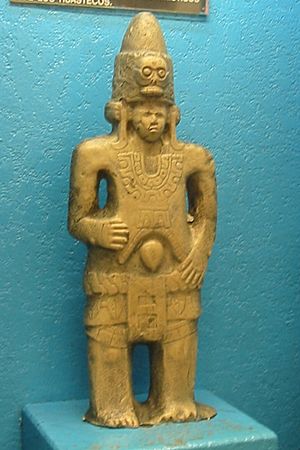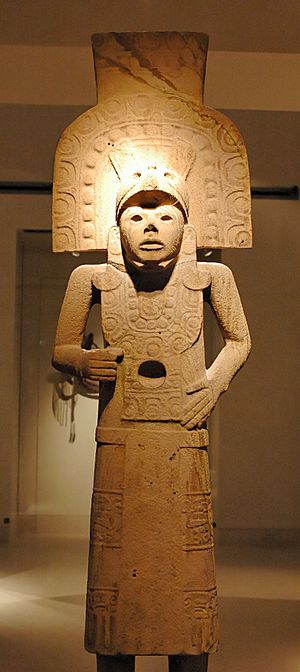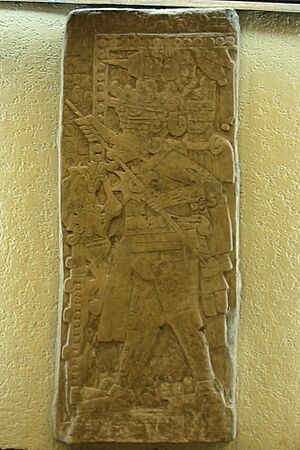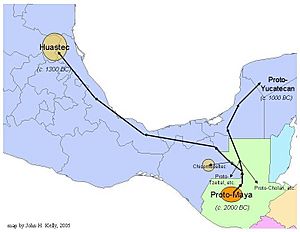Huastec people facts for kids
| Total population | |
|---|---|
| Approximately 66,000 (INAH)–150,000 (Ethnologue 1990) | |
| Regions with significant populations | |
| Mexico (San Luis Potosí: Veracruz: Tamaulipas) | |
| Languages | |
| Wastek, Spanish | |
| Religion | |
| Roman Catholicism | |
| Related ethnic groups | |
| Maya peoples |
The Huastec people, also known as Téenek (meaning "people from here"), are a native group living in Mexico. They live in a region called La Huasteca, which includes parts of the states of Hidalgo, Veracruz, San Luis Potosí, and Tamaulipas. This area is near the Pánuco River and the Gulf of Mexico.
Today, about 66,000 people speak the Huastec language. Most of them live in San Luis Potosí and Veracruz. When the Spanish arrived in 1529, there were likely many more Huastec people, possibly as many as half a million.
The ancient Huastec civilization was one of the important cultures in Mesoamerica before Christopher Columbus arrived. Experts believe they existed as early as 1000 BCE. Their most active period was between the fall of Teotihuacan and the rise of the Aztec Empire. The ancient Huastecs built temples on step-pyramids. They also created impressive sculptures and beautifully painted pottery. Other Mesoamerican groups admired them for their musical talents.
Around 1450, the Aztec armies, led by Moctezuma I, defeated the Huastecs. After this, the Huastecs had to pay taxes to the Aztec Empire. However, they were still able to govern themselves quite a bit.
The Spanish conquered the Huastecs between 1519 and the 1530s. After the Spanish Conquest, many Huastecs were taken from their homes and forced to work in other places, like the Caribbean.
The first written description of the Huastec language for Europeans was by Fray Andrés de Olmos. He also wrote the first descriptions of the Nahuatl and Totonac languages.
Contents
Where the Huastec People Came From
How the Huastec Language Separated from Maya

Scientists who study languages believe that the Huastec language separated from the main Maya language family a very long time ago. This separation happened between 2200 and 1200 BCE. The only other language that came from the same branch as Huastec was Chicomuceltec, which was once spoken in Chiapas but is now extinct.
This early split means that the Huastec language developed differently from other Maya languages. For example, the Huastec word for "man" is inik, while in other Maya languages, it's winik.
Huastec Art and Style
The Huastec people lived north of the Totonacs in Mesoamerica. This location helped them develop a unique art style. They spoke a Mayan language, which was useful for trade. Because they lived near the coast, their art often included items made from shells.
Besides shell artifacts, they also made pots, gaming stones, special pipes, and sculptures. These items often featured human heads, engraved shell necklaces, fan-shaped headdresses, and figures of hunchbacked humans.

Arrival in the Huasteca Region
The Huasteca region stretches from the mountains of the Sierra Madre Oriental to the Gulf of Mexico. It covers parts of northern Veracruz, eastern San Luis Potosí, and southern Tamaulipas. Today, people in this region speak several native languages, including Nahuatl, Pame, and Huastec. The Aztecs, who arrived in the Huasteca around 1450, knew this region for its rich and fertile land. It also has some of the northernmost tropical forests in the Americas.
The Huastecs arrived in the Huasteca region sometime between 1500 BCE and 900 BCE. Archeological finds support this. For example, in 1954, researchers found pottery and figures in the Panuco River area that look like older objects from a Maya site called Uaxactun. This suggests the Huastecs arrived in their current location around 1100 BCE. They stayed in a place called Santa Luisa until the Totonacs took over around 1000 CE.
Why Huastecs and Mayas Separated
The original Maya language, called Proto-Maya, was probably spoken in west-central Guatemala. This area is near the Cuchumatanes mountains. Evidence suggests this was the Maya "heartland" because many different Maya languages are spoken there today. Also, Proto-Maya included words for plants and animals from both mountain and lowland areas.
Whether the Huastecs separated from the rest of the Maya around 2200 BCE or 1200 BCE, it happened at least a thousand years before the famous Classic Maya culture began. This is why the word "to write" is different in Proto-Huastec compared to other Maya languages.
It's likely that the split happened after some Proto-Maya speakers started moving north, possibly along the Usumacinta River. Then, the two groups went in different directions: the Proto-Huastec speakers moved northwest, and the other Maya speakers spread northeast. We don't have direct archeological proof for why they split. However, language clues suggest that contact between the two groups was soon cut off.
The reason for this separation was probably another powerful language group. Many scholars believe this group was the Mixe–Zoque family. These people likely lived in the Gulf Coast lowlands, which was the heartland of the Olmec civilization. The Olmecs, who lived from about 1400 to 500 BCE, are thought to have spoken Mixe–Zoque languages.
Evidence shows that the Proto-Huastecs borrowed words from Proto-Mixe–Zoque as they traveled through the southern Gulf lowlands. For example, the word ciw, meaning "squash," was borrowed. This suggests that the Olmecs, speaking a Mixe–Zoque language, caused the early Huastecs to become separated from other Maya speakers. It also seems that the active presence of the early Olmecs pushed the Huastecs to migrate further up the Gulf coast.

Interestingly, the Huastecs and the Yucatán Maya were connected again in the late 1800s. Huastec workers who collected chicle (a natural gum) and cut lumber were sent to Campeche to work in similar forests there. At the same time, trade by steamship developed across the Gulf of Mexico. Products like salt were sent from Campeche to Tuxpan (a Huastec port), and sugar went from Tuxpan to Campeche.
Images for kids
-
Replica of a Huastec statue in Mexico City. It shows a male figure, possibly Quetzalcoatl, from the Early Post Classic period.
-
Huastec statue from the Tampico Region, made between the 14th and 16th centuries.
-
Replica of a bas relief image in Mexico City. It shows a scene from the Late Classic Period, where an animal licks blood from a priest who sacrificed himself.
See also
 In Spanish: Pueblo huasteco para niños
In Spanish: Pueblo huasteco para niños






